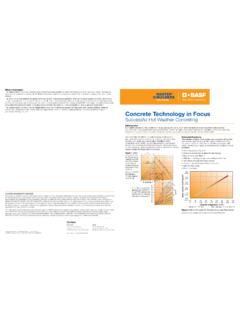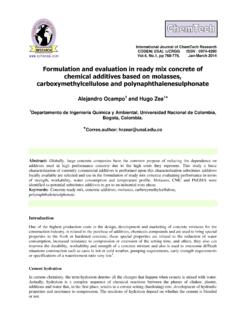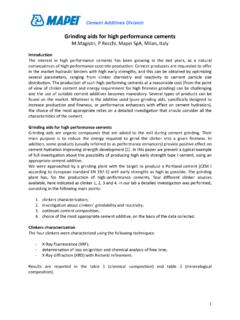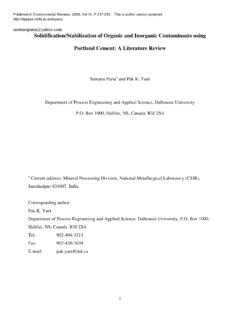Transcription of CEMENT ADDITIVES IReady for the future - BASF
1 CEMENT ADDITIVES82 ICR NOVEMBER 2013 CEMENT manufacturers operate in one of the world s toughest industries. A vast number of new challenges are emerging, pushing plant and human resources to the limits. Operators are faced with the sometimes conflicting tasks of lowering the clinker factor, increasing production throughput, improving energy efficiency as well as performance, and cutting CO2 emissions all while complying with evolving regulatory requirements. In addition, ever-changing fuel mixes and increasing integration of supplementary cementitious materials (SCM) require even more flexibility, and have an impact on CEMENT performance, as well as on quality consistency and robustness.
2 Fly ash and GGBS are being substituted more and more often by natural pozzolans, artificial clays, recycled fines or even by limestone. These SCMs generally have a lower clinker factor reduction potential or have an impact on CEMENT or concrete quality (eg increase of water demand). The efforts and struggles in the US CEMENT sector to increase limestone content in OPC while maintaining original performance levels would be one such example. Moreover, CEMENT producers are exploring new Master Builders Solutions is BASF s new brand of advanced chemical solutions for the global construction industry. The Master Builders Solutions brand is built on the experience of more than 100 years in the construction industry and is a comprehensive portfolio encompassing lasting solutions for CEMENT and concrete production, as well as construction, maintenance, repair and renovation of structures.
3 By Lorenzo Ambrosiniand Peter Schwesig, BASF, Germany IReady for the futureTrostbergShanghaiTrevisoClevelandS o PauloSantiagoPanam Mexico CityBarcelonaIstanbulMumbaiSingaporeSydn eyFigure 3: BASF Construction Chemicals' global R&D centre based in Trostberg, GermanyFigure 2: competences and product portfolioFigure 1: Master Builders Solutions BASF s new brand of advanced chemical solutions for the global construction industryCentral R&DRegional development centresCustomer services labsP82-84 1P82-84 116/10/2013 16:1616/10/2013 16:16 CEMENT ADDITIVESNOVEMBER 2013 ICR 83opportunities with the introduction of new ternary cements (CEM X) based on limestone plus slag, fly ash or pozzolans.
4 On the application side, concrete producers require increasingly robust cements, able to support varying aggregate qualities, climate conditions and applications. Under these premises, a further step in the fundamental understanding of physical-chemical processes that occur during clinkerisation, grinding and CEMENT hydration is a pre-requisite for the optimisation of production processes and costs, and to fulfill customer requirements. This will be even more important in the future , especially looking at the new innovative clinker processes being developed and efforts to increase producer competitivenessThe Master Builders Solutions brand is backed by a global community of BASF construction experts.
5 To solve customers specific challenges, BASF combines know-how across different areas of expertise and regions, drawing on experience gained in countless projects leveraging global BASF technologies, as well as the company s extensive knowledge of local needs, the aim is to drive the aspects of sustainability relevant to the construction industry such as energy efficiency, carbon footprint or the longevity of structures. The company's CEMENT ADDITIVES range is now presented under the MasterCem brand. Its global CEMENT ADDITIVES team encompasses a connected network of commercial and technical specialists. Fundamental research on CEMENT mineralogy and ADDITIVES chemistry and basic developments are carried out in the R&D centre in Trostberg, Germany (see Figure 3).
6 Product formulations are investigated in development centres in Treviso (Italy), Shanghai (China), Cleveland (USA) and S o Paulo (Brazil). The numerous customer service labs around the world ensure market proximity and the ability to answer local needs tools and goalsHigh-level technical equipment is a pre-requisite for producing reliable qualitative and quantitative data from CEMENT and clinker samples. For clinker analysis, one of the most important tools is optical microscopy on etched polished sections. This delivers valued information such as crystal shape and distribution quantities, allowing us to better understand clinker properties (see Figure 4).
7 The common CEMENT analytics routine comprises of X-ray diffraction (XRD) measurements with subsequent Rietveld refinement, to determine the mineralogical phase content. To obtain reliable results, selective extractions of every sample are performed. Furthermore, X-ray fluorescence (XRF) on fused beads is used to assess chemical composition up to trace elements. Calorimetric studies on hydration kinetics are made to measure the reactivity of cements and innovative binders. Various measurement techniques to determine specific surface, particle size and pore distributions of a CEMENT sample are available in-house, such as a laser diffraction analyser, a Blaine instrument and a BET surface area analyser and a pore size analyser.
8 For specific questions, it is often not sufficient to perform a standard analytic procedure. In these cases, it is important to achieve a deeper understanding of the mechanisms that influence the path of CEMENT hydration. Techniques like time-resolved pore solutions analytics (measured with ICP-OES), in-situ XRD measurements with subsequent Rietveld refinement (see Figure 5), or thermodynamic calculations are used to quantify dissolution of clinker phases and the precipitation of hydrates. Also a close insight into the microstructure of Figure 4: etched polished section of a typical Portland CEMENT clinkerFigure 5: phase development of hydrating CEMENT over time by XRD, CSH calculated from Portlandite, free water calculated from phase contentP82-84 2P82-84 216/10/2013 16:1616/10/2013 16:16hydrating cements (see Figure 6a and 6b) or interface morphology of different hydrated components with the help of Cryo-SEM or TEM techniques (see Figure 7) completes the possibilities of CEMENT analytics at BASF's Trostberg labs.
9 A combination of all these techniques allows BASF to draw a detailed picture of the hydration process of each specific CEMENT or clinker. The huge variety of analytical methods is also used for project work and to gather fundamental knowledge on CEMENT systems. Many projects deal with hydration control where a strong emphasis is set on the acceleration of hydrate phase formation during CEMENT hydration. Another important research topic is the effect of supplementary cementitious materials on CEMENT hydration. Researchers investigate the impact of slag, fly ash, pozzolans or silica fume on CEMENT hydration and the possibilities of further clinker replacement.
10 A detailed understanding of the interaction of CEMENT ADDITIVES , concrete admixtures and CEMENT is one of the objectives. One of the most important goals of these investigations is the correlation of the scientific findings in the lab with the actual performance of CEMENT ADDITIVES on clinkers in the grinding process, in mortar and eventually in concrete applications. In addition to the norm testing of mortars and concretes, in-house developed performance tests are also executed, eg a small-scale concrete test that allows us to perform a high number of tests per day. The close contact between inorganic analytics, organic synthesis and the mortar and concrete technology enables us to develop a detailed structure property relationship between clinker/ CEMENT and this deep analytical understanding and BASF s experience from several hundreds of cements and clinkers from all over the world, the company is able to categorise the different clinkers and estimate their performance with respect to different ADDITIVES .

















